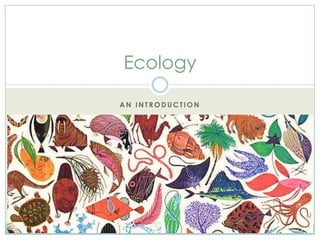
Introduction to Ecology
- 2. Key Words SOME THINGS YOU NEED TO KNOW
- 3. Ecology from Greek: oikos, meaning “house”. First coined by Ernst Haeckel, a German biologist, in 1866. He related houses as the levels of organization.
- 4. Biosphere Portions of the planet in which life exists. Self-contained and self-regulating Patchy
- 5. Ecosystem & Ecotone Ecosystem Not self-contained Abiotic ↔ Biotic Removing biotic elements can dramatically affect an ecosystem’s abiotic conditions Ecotone The overlap between two or more ecosystems/ biomes
- 6. Habitat & Niche Habitat The area where an organism lives An organism’s home or address Niche Conditions in which an organism lives The way an organism uses these conditions An organism’s job or occupation
- 7. Ecological Succession PIONEERS TO GENTLEMEN
- 8. Types of Successions Ecological Succession An existing community is replaced by another community Directional Usually predictable Primary Succession Starts with virtually lifeless area; the soil has not formed yet or has been destroyed Secondary Succession Occurs when an existing community has been cleared by some disturbance without destroying the soil
- 9. Communities Pioneer Community Colonizes areas where no community exists Climax Community A fairly stable collection of organisms that results from ecological succession Dominant Species Most obvious or numerous species in a community
- 11. Tundra Coldest Dry Northern Hemisphere Flora Stunted trees , dwarf woody shrubs , mosses , lichen , grass Fauna Reindeer , migratory animals (feed on plants during the summer0 , wolves , foxes , mosquitoes ,
- 12. Grassland Warm to Hot Wet and Dry seasons All continents except Antarctica Flora Grasses , few trees Fauna Mammals ( giraffes , zebras , lions , etc. ) , birds , insects
- 13. Desert Extreme Temperature Very Dry Tropical and Temperate Zones Flora Cactus , sage bush , dwarf shrubs , short woody trees Fauna Kangaroo mice , lizards , insects , scorpions , snakes , birds
- 14. Taiga A.K.A. Coniferous Forest Cool Year-round Adequate Rainfall Underneath Tundra Biomes Flora Conifers Fauna Black Bears , wolves , moose , migratory birds (during summer)
- 15. Deciduous Forest Seasons Summer , fall , winter , spring Adequate Rainfall Temperate Zones Flora Deciduous Trees
- 16. Tropical Rainforest Always Warm Very Wet Between Tropics of Cancer and Capricorn Flora Vines , palms , orchids , ferns
- 17. Freshwater Less than 1% salinity Standing water Littoral Zone Near Shore Limnetic Zone Near-surface Open Water Profundal Zone Deep Water Flowing water
- 18. Estuarine Salinity is more than 1% but less than 3% Organisms are highly tolerant to salt Spawning Grounds High Biodiversity per unit area Highly Productive Because of the nutrients deposited by the river or stream, low depth and high light exposure
- 19. Marine More than 3% salinity Zones Intertidal Low/high tide area Pelagic Open Ocean Benthic Ocean Floor Abyssal Deep Ocean
- 20. Energy Flow PYRAMIDS AND CHAINS
- 21. Ecological Pyramids Shows the relative amounts of energy/matter contained at each trophic level
- 22. Feeding Relationships Food Chain Organisms transfer energy by eating and being eaten Food Web Network of complex feeding relationships Only 10% of the energy of an organism is passed on to the organism that eats it
- 23. Population Dynamics PLUS MINUS
- 24. Characteristics of a Population Geographic Distribution or Range The natural arrangements of organisms in particular geographic locations Population Density The number of individuals per unit area Population Dispersion Pattern in spacing between other members of the population Clumped , uniform , and random
- 25. Characteristics of a Population Age Structure Distribution of the population to different age groups. Growth rate 3 Factors affecting the population size Natality Mortality Migration Number of organisms added or taken away from a population
- 26. Growth Rate Exponential Individuals in a population reproduce at a constant rate. Logistic A populations growth stops after a period of exponential growth Biotic Potential Maximum growth rate under ideal conditions Carrying Capacity Maximum population size an environment can sustain Environmental Resistance Environmental conditions that limit a population’s growth
- 27. Population Pyramid Types Growing Stable population growth Expanding Stationary Contracting Exponential population growth Stationary No population growth Contracting Decreasing population growth Expanding Growing
- 28. Core Concepts Five important characteristics of a population Three factors affect a population’s size Biotic potential of an ecosystem is affected by environmental resistance , thus resulting in a maximum carrying capacity Factors that limit population growth include both density-dependent and density- independent factors Understanding the patterns in human population growth is important in addressing population problems around the world
- 29. Factors Limiting Population Growth Limiting factor A factor that causes the population growth to decrease Density-dependent factors Becomes limiting when a population reaches a certain size Competition Diseases Density-independent factors Not affected by the size of the population Natural Disasters
